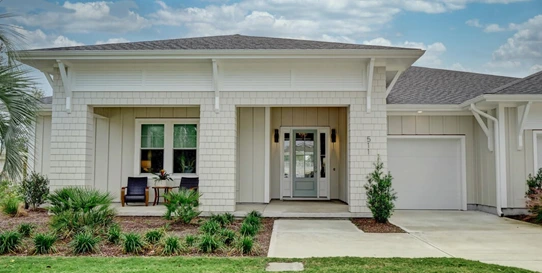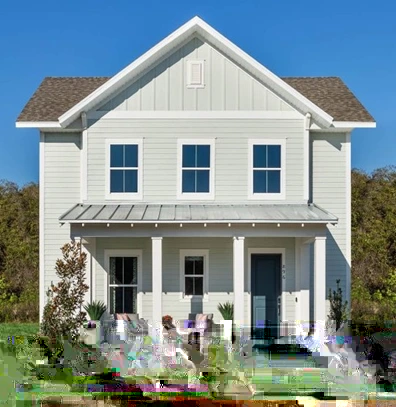This oversized 75′ x 125′ lot sits outside the flood zone, offering peace of mind and plenty of space for a pool. Single-story floor plans are available, providing the perfect foundation for a custom coastal retreat.
Author: Richard Wallace
5 Critical Questions to Ask Before You Build Your Coastal Home
Building a home on the Carolina coast is a dream for many – and for good reason. The salty breeze, stunning views, and laid-back lifestyle make coastal living irresistible. But before you break ground, it’s important to ask the right questions. A custom coastal home presents unique opportunities – and challenges – that require careful consideration.
At Richard Wallace Builder, we guide homeowners through every step of the journey with clarity and care. Here are five critical questions to ask before you start building your coastal retreat.
1. Is My Home Designed to Withstand Coastal Conditions?
Coastal homes face weather realities that inland homes don’t: high winds, humidity, salty air, and potential hurricanes. It’s essential to ask your builder:
- What structural reinforcements will be used?
- Is the home built to Fortified standards?
- What materials are best for coastal durability?
Why it matters: Storm-resilient construction and low-maintenance materials help protect your investments for decades.
2. How Can I Maximize the Views From My Lot?
The view is one of the biggest draws of coastal living – whether it’s ocean, marsh, or a canopy of live oaks.
Ask your builder:
- What’s the orientation of the lot in relation to sunrise, sunset, or water lines?
- Should main living spaces be placed upstairs?
- Can windows, porches, or roof decks be positioned to enhance views?
Why it matters: Thoughtful design can turn a “nice” view into a breathtaking one. And since the view won’t change – but your needs might – planning for future sightlines is a wise move.
3. Am I Designing for Function – or Just for Style?
Coastal homes often welcome visitors – family, friends, and future grandkids. You need spaces that adapt.
Ask:
- Can guest rooms double as offices or hobby spaces?
- Should we include a flex room or bunk area?
- How do we balance open-concept living with quiet corners for privacy?
Why it matters: Multifunctional spaces future-proof your home. The right design can support weekend entertaining and everyday comfort.
4. What’s Included in the Price – and What’s Not?
Surprises are great for birthday parties – not for budgets. Coastal building comes with added costs (like impact-rated windows or special foundations), so clarity is key.
Ask:
- Is this a fixed-price or cost-plus contract?
- Are allowances for finishes realistic?
- What could cause the final price to change?
Why it matters: Fixed-price contracts, like those used in The Wallace Way, offer peace of mind with no hidden fees.
5. How Will I Stay Informed During the Build – Especially If I Live Elsewhere?
Many of our clients are building from out of state, so communication is key.
Ask:
- How often will I receive updates or photos?
- What tools or portals are used to track progress?
- Who is my main point of contact throughout the build?
Why it matters: With the Wallace Way, you get weekly reports, site photos, and a dedicated project manager – so you’re always in the loop, even from miles away.
Ready to Build with Confidence?
The best coastal homes are the ones designed with clarity, care, and experience. At Richard Wallace Builder, we bring decades of coastal insight to every project – and guide our clients with honesty and transparency every step of the way.
Let’s talk about your vision. Whether you’re retiring here or building your weekend retreat, we’re here to help make it feel like home from the start.
About Richard Wallace Builder
Richard Wallace Builder is a trusted custom home builder serving North Carolina’s southern coast since 1976. Known for its commitment to craftsmanship, accountability, and personalized client experience, RWB offers homeowners peace of mind through its proprietary process, The Wallace Way™. With clear communication, transparent pricing, meticulous project management, and exceptional coastal expertise, Richard Wallace Builder creates homes that reflect the timeless character and lifestyle unique to Coastal Carolina. Learn more about Richard Wallace Builder at richardwallacebuilder.com.
Home Sweet Home – Part 49 – Unlocking Your Home Potential In Retirement
Many of you reading this are already enjoying retirement. Others see this glorious milestone in their near future. And for those of you who have years before you can retire, I beseech you to not wish your life away—the years go by all too quickly the older one gets. Nonetheless, I can tell you that a strange and wonderful transformation generally occurs within the home not too long after retirement. Rooms that were either rarely used during the day or were occupied by your children while you were raising them, can, and undoubtedly will, find a renewed purpose.

KITCHEN
Without the need to rush off to the office, retirees have more time to cook. Some even find cooking to be a new hobby. Now, they have time to experiment with different recipes or cooking techniques. Cooking becomes a holistic process, and the kitchen is suddenly a place for creativity, relaxation, and entertainment. This newfound passion might even call for a kitchen remodel, or at the very least, a new appliance or two.
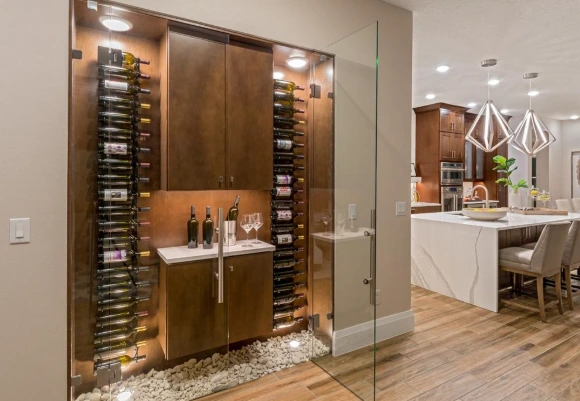
WINE DISPLAY
And with this newfound time for entertaining, sharing a glass of wine or two with neighbors, or even hosting a wine tasting event, becomes more commonplace. Drinking wine is different than other beverages. It is enjoyed more slowly. First, you swirl it in the glass, followed by a wonderful inhale of its aroma. Then, you sip it – maybe even swirl it around in your mouth to get the full experience. This slow, deliberate process exudes relaxation. For this reason, I think adding a wine display is perfect for retires who enjoy and want to share their wine.
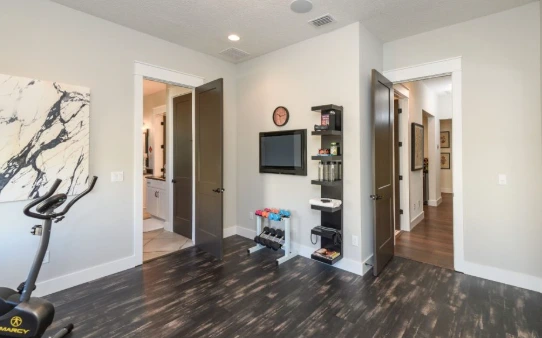
HOBBY ROOMS
With more free time, retirees can take up new hobbies. This often means that one of the extra bedrooms can be used for anything except a sleeping room. It could become a sewing room or crafting room. How about a music room – for either listening to music or playing music? What about a room for yoga, Pilates, or meditation? But if you need this room for sleeping on occasion, add a wall bed or Murphy bed, the room can be “the whatever you want room” most of the year—and a guest sleeping room when needed.
PET ROOMS
Pets oftentimes become the surrogate children or grandchildren. They are our constant companion in retirement and a source of unconditional love. So, ditch the carpet and replace it with the latest in flooring that doesn’t scratch under dogs’ paws and cleans up easily should an accident occur. Designate an area specifically for your beloved four-legged friend that includes food and water bowls, a basket for squeaky toys and a comfy bed!

HIS AND HER GET AWAY SPACES
After years of working 8 hours a day in an office 5 days a week, many retirees find that they suddenly have too much “togetherness time.” Best way to remedy that is by each having their own getaway space. That’s why second floor man cave or game room is so popular.
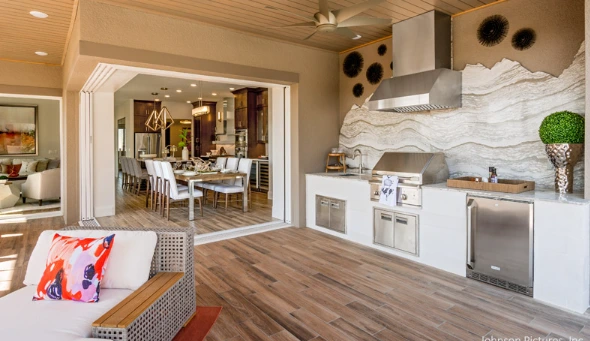
OUTDOOR LIVING
Since you are no longer confined in an office, making the most of the great outdoors is paramount. Consider expanding your outdoor living spaces—after all, you now have more time to enjoy it—both during the day and the evening. I like to include a place to lounge with a fireplace and/or TV. Add a grilling station or outdoor kitchen and rediscover how much better food tastes when cooked outside on the grill. And don’t forget the outdoor dining table—preferably away from the heat of the grill with comfortable and ample seating for friends and family to gather. Dare I say, add a pool…
If your home is too large for you in retirement, I encourage you to build one that will allow you to comfortably age in place. If you love your current home, I suggest that you remodel a room or two. So here’s to making the most of our homes at this incredible stage in life.
Adapted from Housing Design Matters Blog
In Defense (& Favor) of the Kitchen Island
Did you see the recent article in the Wall Street Journal “Why a Kitchen Table Beats an Island – According to People Who Made the Switch?” A friend forwarded it to me and wanted to know my thoughts.
Suffice to say, I do not agree with those interviewed. There are endless possibilities for the size, shape, finish, and style of a kitchen island. I also find it extremely functional. My favorite feature of the kitchen island is how inclusive it is for both those cooking and those congregating.
Seems the designers in the article preferred the kitchen table in the middle of their kitchen versus the “ubiquitous” center island. They felt the kitchen table was homier and more welcoming. Of course, they showed pictures of big rustic farmhouse tables. Others felt like the island was too tall for small children and preferred their kids to sit at a table. Another didn’t like that you sat side by side versus across from one another.
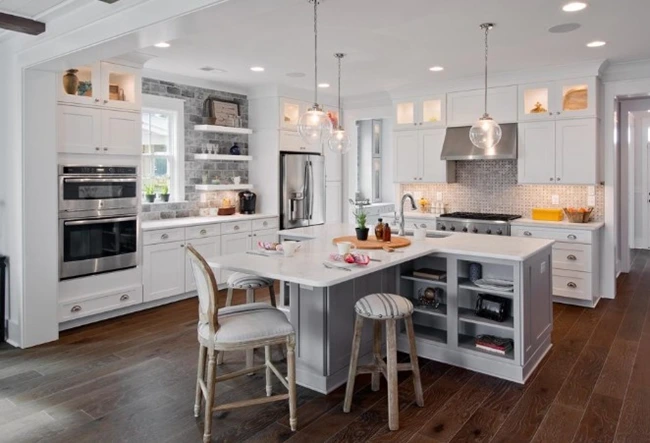
Not to be the contrarian in the room, but I disagree with every one of these points. Look, if you find yourself wanting an island-less kitchen, that’s all well and good. However, I don’t think this is a trend that will stick. Allow me to tackle the objections that the article lays out.
ISLAND STYLE
Since the island is composed of cabinets, they can come in a variety of styles and finishes. If you desire a homier look, select wood cabinets. Add table legs at either side of the island supporting the overhang for a more furniture-feel. You can even add bookshelves to the ends of the cabinets for cookbooks or knickknacks.
Of course, if your tastes are more contemporary, you can select a more modern design with perhaps a waterfall countertop or perhaps corrugated metal siding along the face of the island for a fun industrial vibe.

ISLAND HEIGHT
It used to be the seating area at the island was bar height at 42” above the floor, which made for very tall bar stools. I find the island much more welcoming at 36″ above the floor – the same height as the rest of the kitchen countertops. That makes the island suitable for standing and food preparation. A kitchen table is only 30” above the floor – leaving it unsuitable for chopping vegetables. However, you can design an island to have dual heights – 36” on the kitchen side and 30” on the dining side.

ARRANGEMENT OF CHAIRS
There is no rule that says the island stools must all be in a single line. Indeed, I recommend having at least one chair at 90 degrees. Many kitchen islands have seating on three sides making it just as conversational as a table.
INCLUSIVE
One photo in the article showed a single countertop along the back wall of the kitchen with sink and range. This means whether the “chef” is washing vegetables or stir frying on the stove, their back is to anyone seated at the kitchen table. And since the table is too low for food preparation – their back is always to the rest of the room. In my opinion (and the opinion of many others), that is not how I wanted to interact with my family when I was a working mom or with my friends as an empty nester.

Personally, I find that islands have become the place where family and friends gather. So, has the kitchen island overstayed its welcome? Or is the “island-less kitchen” another niche trend to be ignored?
Adapted from Housing Design Matters Blog
Home Sweet Home – Part 48 – Bringing Joy Into A Home
“Choose Joy” is the favorite saying of my longtime friend, Nancy. She ends every email in it and often uses the phrase to diffuse conflicts in her office.
While it seems like a simple concept, it’s actually very powerful. Turns out, joy is more powerful than good genes according to an 80-year Harvard study of their graduates. The ones who found joy in life lived longer.
This begs the question: How can we add or facilitate joy in our homes?

Outdoor living is an essential component of a joyful house, especially when you consider our fascination with and connection to nature. Trees help to make a yard or a neighborhood joyful. The same goes for a colorful landscape. Include both evergreen and deciduous trees so there is always some green. Fresh flowers are always joyful, so include a seasonal rotation of annuals.

I think a joyful home includes an interactive kitchen. I want the person preparing the food to be connected to friends and family – not locked away in some utilitarian chore space as was the norm in the sixties and seventies.

Of course, our pets bring us great joy! They are always happy to see us when we come home. Having a home that makes it easy to care for and accommodate our pets reduces the less-joyful moments that can come with pet ownership. This could be as simple as finding a place for the pets’ food, water, and bed that is out of the high traffic zones.

Light by itself is joyful, but thoughtful lighting is even more so. Consider ambient, task, accent, and decorative lighting. Add some undercabinet lighting and prepping meals becomes more fun. Perhaps change out your pendant fixtures over the kitchen island to give your home a fresh new look. Add a beautiful piece of art and showcase it with a portrait light.
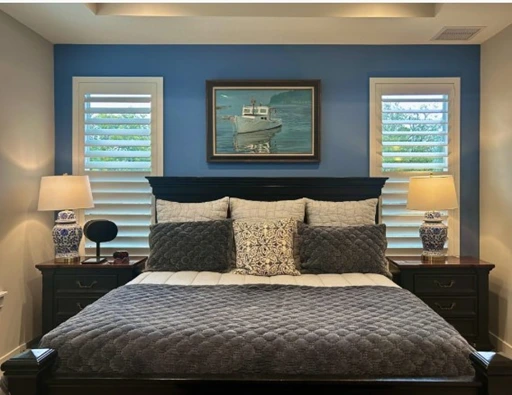
Adding color to the interior of homes can be tricky but worth the risk if you are looking to add joy. There is an entire industry that focuses on the effect color has on people. Yellow, orange, and blue are colors that evoke feelings of joy. Yellow is often linked to the power and energy of the sun and is strongly associated with laughter. While red symbolizes passion, orange serves as a balanced alternative, declared by Frank Sinatra as the happiest color. Blue represents trust and serenity, bringing a sense of calmness. Of course, color preference is very personal, so different colors resonate with people differently.

I have always found the ability to personalize the places we call home to be very powerful. This could be as simple as selecting some cool art for your walls or swapping out old facets in the bathroom with something more elegant. But it could also be more extravagant like building a wine display or wine wall. Hey – let’s face it. Wine is joyful.

Adding joy to your home impacts your health and longevity—so plant some colorful flowers or shrubs that bloom, switch the paint color in your bedroom, replace a vanity light or chandelier, build a firepit and enjoy the great outdoors all year long—the result will be a happier you!
Adapted from Housing Design Matters Blog
Home Sweet Home – Part 47 – The Bathtub Enjoys Another Resurgence
Have you ever had the opportunity to visit Kohler, Wisconsin and wander around the Kohler Design Center and the Kohler Museum on the floor below?
If so, you were probably struck by the story of the first “modern” bathtub. In 1883 John Michael Kohler took a cast iron horse trough, covered it in enamel, and added four decorative feet—the precursor of the claw-footed tub. The one featured in the museum is a later model – 1905. This one looks a bit more ergonomically designed than what I imagine a horse trough would be.
Kohler also invented the first cast iron skirted bathtub and the one in the museum looks like many tubs we see today.

Over the years, bath designers have been tweaking and modifying the bathtub. The “roman” tub was a large, deep tub designed for soaking and was typically dropped into a platform surrounded with tile.
I believe the eighties were the heyday of the whirlpool bathtub. We designed primary baths with giant whirlpool bathtubs and tiny showers. Tubs those days were mostly oval and still dropped into a platform surrounded with tile.

But with the new millennium, showers started to grow in both size and popularity. Let’s face it, no one wants to take a shower in a 3′ by 3′ “phone booth”. As the shower grew, so did its features. A single faucet was no longer enough. We needed pulsating, messaging jets of water, rain head shower faucets, body sprayers, and handheld shower heads.
When the great recession hit the housing market, December 2007 through June 2009, both showers and bathtubs were downsized again and many features were downgraded. Many plans eliminated the bathtub altogether.

Let’s face it, there is something wonderful about taking a relaxing bath. Add a cool faucet to fill your tub and you have a full-blown water feature inside your home. The sound of running water, and the look of it if you select a cascading waterfall style faucet, is almost as relaxing and soothing as soaking in the tub!
But what if you could have your cake and eat it too ? What about an awesome shower and an elegant tub – not a giant oval dropped into a sea of tile – but instead one that is free standing and sculptural. Today’s freestanding tubs have taken that first claw-footed tub and combined it with the convenience of the skirted-tub and created a piece of art that you can relax in – the perfect way to unwind and eliminate all the stresses of the day.
My favorite – the Veil – is pictured above. I just love the sensuous curves and the non-symmetrical shape – quite the journey from a horse trough with feet!
Adapted from Housing Design Matters Blog
Home Sweet Home – Part 46 – HOME IDEAS TO LIVE BETTER AT ANY AGE, BUT DEFINITELY AT 55+
Let’s face it, even though most of us fight growing old, it happens. Aging affects many aspects of our lives, but the ability to live in our home—safely and comfortably—is paramount. Let’s talk about the ways our homes can respond to the unique changes that happen to all of us as we age.
EASY AND EFFORTLESS LIVING
Some of the items being addressed can only be implemented if you are designing/building a new home. Others can easily be incorporated into a remodel/update.
If you are designing a home, perhaps a mono-slab foundation will serve you better than a crawl space as a slab foundation can be a single, low step into the home. If a crawl space is preferable, think about a gently sloping ramp at one door location as they are easier to traverse than a set of stairs. Who wouldn’t want to roll their suitcases into the home, rather than the bump, bump, bump up the stairs?
Larger doors are great for wheelchair accessibility should it become necessary, but they are also invaluable when it comes to getting larger furniture pieces into the home. A minimum of 2′-8” wide door is recommended.
In the bathroom, who doesn’t want a zero-entry shower? Done correctly, it feels luxurious – not geriatric. Why not include grab bars that matches the rest of the bathroom hardware—in the shower and by the toilet—especially in the primary bathroom? A bench seat in the shower is a must!

In the kitchen, people of all ages would appreciate a convenient location for the microwave. Whether it is a senior citizen or a young child, reaching above the range to access the microwave is awkward and potentially dangerous.

LIGHT IT UP
The need for generous lighting is critical as we age. The lens of the eye thickens, allowing less light to pass through. The result is a 60-year-old needs six times as much light as a 20-year-old. Fortunately, adding light is an important option when designing or remodeling. I recommend both layered and way-finding lights. Lights under the upper cabinets in the kitchen are a great way to add an additional layer of light. It also lights up the workspace and eliminates shadows from an overhead light.
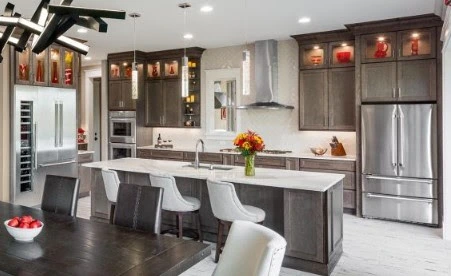
Way-finding light can be as simple as adding a night light feature to existing switches and outlets. I recommend this feature in hallways, stairs, and the path to the bathroom. And who doesn’t appreciate natural light, so be sure to add as many windows as possible if you are in the design stage of building a home.
In the bathroom, take cues from luxury hotels and install a lighted mirror. Not only does it offer great light, but it delivers it in the most flattering form. That is, it doesn’t exaggerate shadows to wrinkles. Add LED strip lighting above each hanging rod in the closet to help you distinguish black from navy blue.
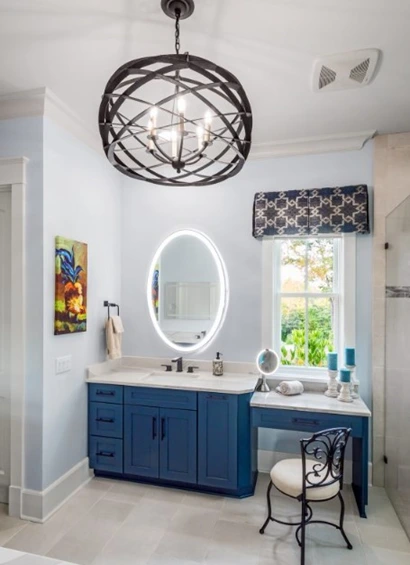
LOW-MAINTENANCE FINISHES
When was the last time someone (of any age) said they wanted a high maintenance house? Fortunately, with the improvements in flooring in the past few years, floors can be durable, affordable, attractive and most importantly, low maintenance. Other low-maintenance finishes to consider are quartz countertops instead of granite which need regular sealing and large format tile in the bathroom to minimize grout which can be a pain to clean.

ACCESSIBLE STORAGE
While all people want ample and convenient storage, those of us 55+ need that and then some. If you are designing a home, incorporating additional storage in a garage is a great idea—make it 42” deeper than what is needed to park a car. This allows for decent garage storage. If your plan allows for a stair to be added at the end of the garage to reach the attic storage, do it despite the extra cost. This is a far more convenient way to access attic storage – not to mention safer. If you aren’t building, a garage organization system can go a long way to making items needed regularly easily accessible.
So, even if you haven’t hit the 55+ milestone, many of these suggestions should not only be considered, but implemented in your home. It will not only allow you to age in place if you remain in your home but will also increase the appeal of your home to a larger segment of buyers if you decide to sell. Here’s to staying young at heart and making the most of aging!
Adapted from Housing Design Matters Blog
Home Sweet Home – Part 45 – Outdoor Living In A Winter Wonderland
Now that Thanksgiving has passed, winter weather is sure to arrive. Over the last decade, outdoor living has become a major trend. Our desire to connect with the great outdoors all year is evident in most backyards nowadays. And by adding a source of heat to these spaces, we no longer allow the cold weather to trap us inside. When this happens, our houses become smaller. I thought now would be a good time to review some cold weather adaptations for outdoor living.

Sorry for stating the obvious – but when it comes to ways to add heat, there are several choices:
FIREPLACES
A lot of outdoor living spaces have fireplaces. But the location and type of fire makes a difference. For example, you could have an alcohol fireplace. This type of fireplace doesn’t require a flue and may be best suited for moderate climates. The key to determining the best type of fireplace and fuel is the BTU it has the potential to produce. I was surprised to learn that propane burns hotter than natural gas.

A wood burning fireplace has the potential to burn the hottest, but it requires constant effort to feed the flame. It also produces lots of smoke.
Since heat rises, having a fireplace in a covered outdoor living area can help trap and contain the heat verses a free-standing outdoor fireplace. But even a firepit, in an open air area can provide warmth if you pull your chair up close enough. And the ambience dancing flames create is unparalleled.
 PORTABLE HEATERS
PORTABLE HEATERS
If you have ever dined outside at restaurants, you have undoubtedly seen a variety of portable outdoor heaters. Many use propane as their fuel and come with wheels and a cover for the propane tank. You can easily get a heater online. When I typed in outdoor patios heater at Home Depot, it gave me 59,509 results. They come in a variety of shapes, sizes, styles, and price ranges. If you’re looking for an outdoor heater, there’s an abundance to choose from.
If you want something more permanent, you might want to consider a ceiling-mounted permanent heater. Most permanently mounted heaters are electric, but you can also run a gas line to a ceiling mounted heater. The early versions of these heaters were rather crude. Indeed, just a ceiling mounted space heater. But the rise in popularity of outdoor living has led to more aesthetically pleasing choices. Most use radiant heat which means they heat objects instead of the air.
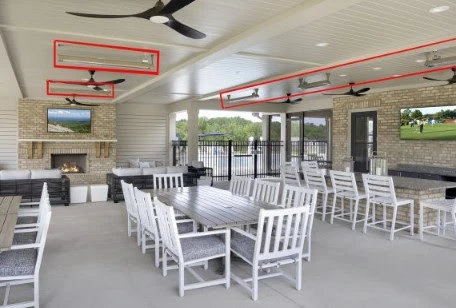
KEEPING THE HEAT IN AND THE WIND OUT
Many restaurants and homes have started adding roll down clear vinyl shades. You can get them manual or powered. The key is they keep the wind out and the warm air from your heat source in – all while not blocking your view. You feel connected to the outdoors while staying warm. This is a great way to capture the feeling of being outside without freezing to death on those frigid days.
Here’s wishing you a warm and toasty winter season!
Adapted from Housing Design Matters Blog
Home Sweet Home – Part 44 – What Makes A House A Home
What makes a house a home? Of course, the short answer is that “people make a house a home.” But what else? What other things should a house provide to promote that feeling that nothing in the world is better than “home sweet home.”
A PLACE TO GATHER
A home should provide and promote the coming together of family and friends. So, an open-concept plan, where kitchen, living and dining space are connected, without walls of separation, truly facilitates this idea. Since the kitchen is the heart of the home, the cook needs to be connected to friends, family, and activities while preparing a meal for all to enjoy. This could include a three-sided kitchen island where it is easy to gather around while not being underfoot as meals are prepped.
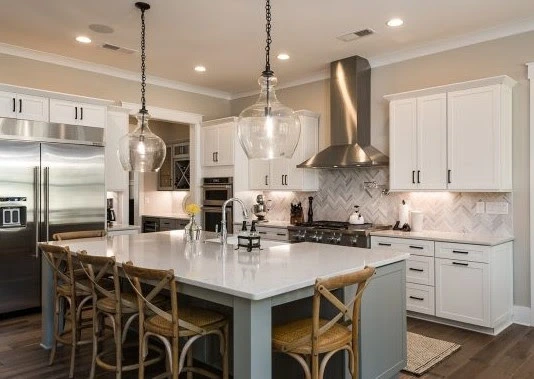 A PLACE FOR REST AND REJUVENATION
A PLACE FOR REST AND REJUVENATION
A home also needs to promote rest and rejuvenation. Of course, this means well-designed bedrooms for sleeping. But it also could include a spa-like bath with a refreshing shower to start the day or a soaking tub to unwind at the end of the day.
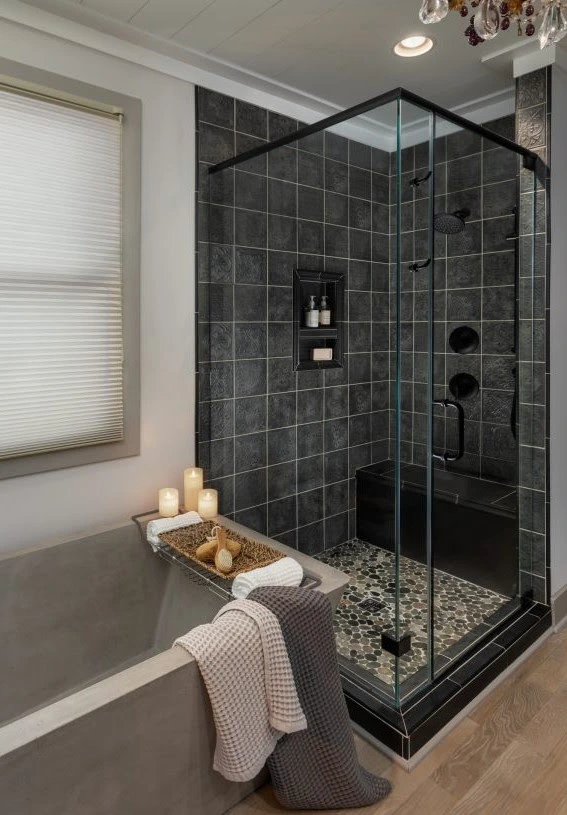
OUTDOOR LIVING
We certainly learned during the pandemic lockdown the importance of outdoor spaces. We no longer take for granted to importance of fresh air, sunshine, and all nature has to offer. Outdoor living is multi-functional—it’s both a source of rejuvenation and provides a delightful gathering space.
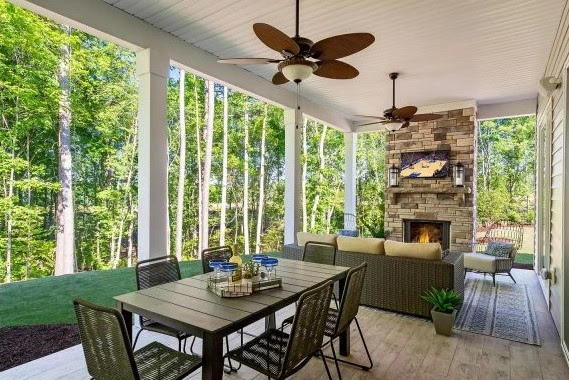
PRIVACY AND INTIMACY
We all need privacy at various times of the day. Houses should include both public and private zones. We need privacy oftentimes when we work from home. Privacy is necessary when we bathe and when we use the toilet (I’ll spell it out – the toilet room needs a door). Naturally, that privacy also includes a place for intimacy which should have both visual and acoustical privacy (I won’t spell this one out).

SELF-EXPRESSION
Personal elements can be transformative. It might be family pictures or memorabilia. It could be the pop of color on an accent wall. Or the furnishings that convert a room into a man-cave or sports bar. Nothing makes a house a home like putting your personal touches throughout it.
 PET FRIENDLY
PET FRIENDLY
In so many households today, pets are a part of the family. Creating space for our furry friends could include the space under the stairs for the dog’s bed or room in the laundry room for a cat’s litter box, or simply a designated place for the pet’s water and food bowls so we don’t trip on them and make a mess.
Big and small details are what help make a house a home. And everyone has a different vision for their home. But no matter what, I do believe most of us agree with Dorothy from the Wizard of Oz: “There’s no place like home!”
Adapted from Housing Design Matters Blog
Home Sweet Home – Part 43 – WHAT’S HOT IN TODAY’S HIGH-END KITCHENS
What is more important in a kitchen – how it looks or if it is functional? The correct answer is that both are important. But in today’s world, the look is becoming more important than pure functionality.
It starts with the appliances and cabinets. I say this somewhat in jest, but a custom range hood can cost the same as an inexpensive new car. This kind of investment sets the tone for the entire kitchen. It’s not enough to have top-of-the-line appliances, they must have cabinet fronts across them for a sleek and seamless finish.
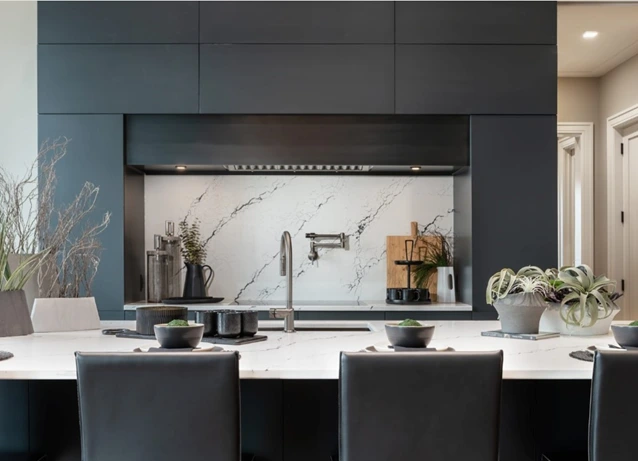
Today’s high-end homes don’t only have a kitchen, but include a Messy Kitchen, otherwise known as a Scullery. Here, you will likely find a second refrigerator, sink, dishwasher – maybe even a built-in coffee maker that is pre-plumbed, and of course, ample cabinetry.
Don’t forget the pantry. They are no longer the size of a linen closet but are now spacious walk-in pantries with both open shelves, baskets, and extra cabinets.
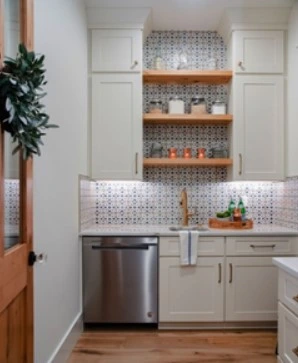
Other items include the giant eight burner gas cook tops or ranges. Those that want it all require – a pizza oven, double wall ovens with features like an air fryer and steaming feature. An inconspicuous drawer microwave is a given! Take it to the next level with a lit wine cabinet that can host hundreds of bottles.
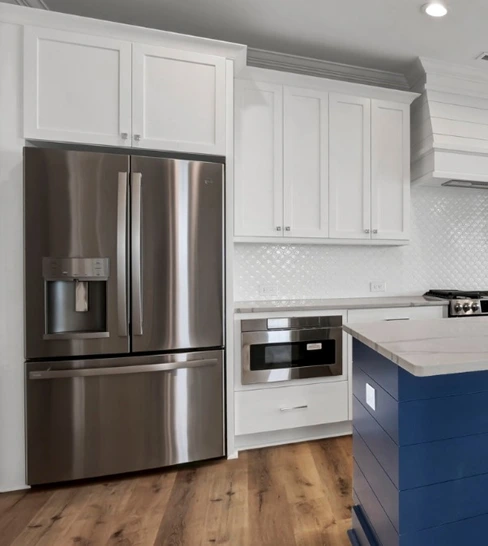
Cabinets are double stacked with glass fronts on the top layer. Add LED or puck lights to the upper cabinets and LED strip lights below for task lighting. And speaking of lighting – the pendant lights hanging over the island are truly the jewelry of the kitchen. Combine these with a kitchen island fully clad in cabinets and a quartz waterfall countertop and this becomes the centerpiece of the kitchen. Comfortable barstools, with a minimum of four, but preferably six, makes this space the heart of your home.
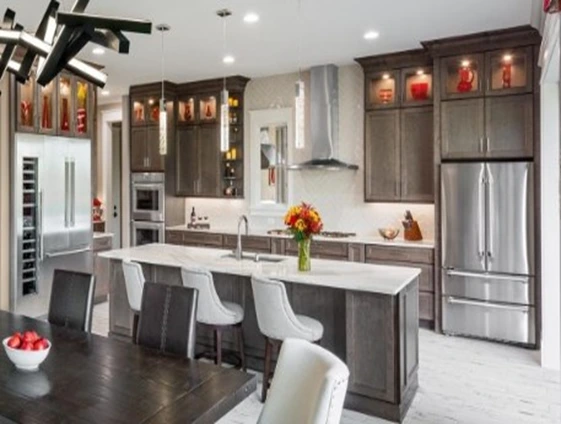
Quartz or quartzite is a must – and not just for the countertops. Running these products up from countertop to ceiling is beautiful and practical – but it’s also expensive. A less expensive alternative is to run a tile backsplash to the ceiling.
As far as sinks go, the farmhouse style is still trending and is available in a variety of finishes including concrete.
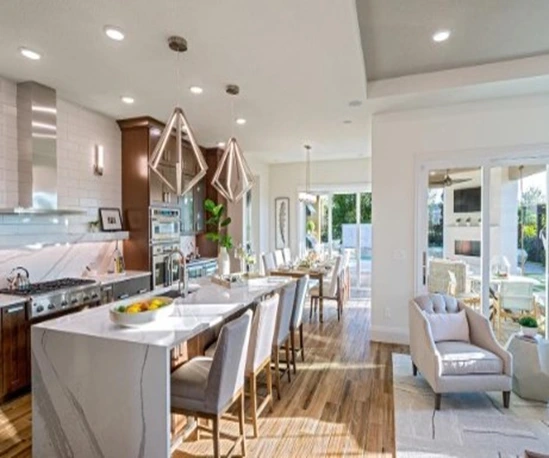
WHAT’S OUT?
Remember pot fillers? These seem to be losing favor among the high-end kitchen designers. Warming drawers seem to be out – at least in the south. Maybe because it’s too warm here already.
Not everyone has the space or means to have a totally high-end kitchen. But as you design a kitchen for your new home or plan a remodel, consider the look you are trying to achieve and incorporate the features that are most important to you. Flair and functionality in a kitchen do not have to compete, they can occur simultaneously, which will truly make the kitchen the favorite room in your home.
Adapted from Housing Design Matters Blog



